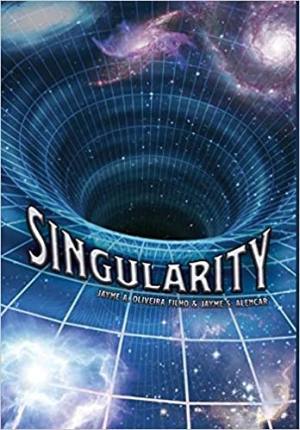Singularity
Second Edition
Following a family that confronts climate change, the novella Singularity reads like a love letter to science.
A family’s perseverance leads to breakthrough scientific discoveries in Jayme A. Oliveira Filho and Jayme S. Alencar’s science fiction novella Singularity.
In the quite near future, Joseph is struck by the certainty that humanity will not be able to avoid catastrophic, climate change-induced extinction. While watching his daughter, Daisy, jump on a trampoline, he begins a thought experiment: What if the point from which the Big Bang exploded was the other side of a black hole? And what if black holes were wormholes, the fast way to traverse the distance between two points?
Joseph sets out to refine and test his theory, knowing that he may experience censure and be made a laughingstock. Such a theory takes time to develop, though. His decades-long dedication inspires his daughter and grandson to take up science and continue his studies. Building off of each other’s work, they suggest a new option in the race against the climate change clock.
Based in solid science, the book introduces complex concepts, including quantum theory and multiverse theory, in concise, digestible terms. It includes parenthetical citations and in-text attributions for Einstein’s Theory of Relativity and Antoine Lavoisier’s discovery of oxygen and its role in combustion. And many of the ideas that are central to the story are presented as common knowledge, as with its examples of the effects of climate change. Droughts, coastal erosion, and erratic weather patterns are mentioned multiple times, with the understanding that the severity and duration of such events have been influenced by human action and inaction.
There are few conversations in this novella, which reads like an oral narration. Its tone is dry, and while its progression is steady, it includes large time jumps in its short space. Years pass in the space of a sentence or a paragraph, and narrative beats seem to be missing as a result. Scenes start and end in a too-abrupt manner.
Still, the characters are developed in a holistic manner. The family’s drive to create a viable solution for climate change is motivated by love, and their hard work, determination, and faith are pronounced. Religion becomes a more prominent force as the book marches towards its conclusion. The story culminates with a clear statement on the harmonious relationship that can exist between religion and science.
The science-based novella Singularity is a story with a purpose. It reads like a love letter to science’s ability to make the universe understandable, as well as to science’s usefulness in finding a solution to climate change-induced extinction.
Reviewed by
Dontaná McPherson-Joseph
Disclosure: This article is not an endorsement, but a review. The publisher of this book provided free copies of the book and paid a small fee to have their book reviewed by a professional reviewer. Foreword Reviews and Clarion Reviews make no guarantee that the publisher will receive a positive review. Foreword Magazine, Inc. is disclosing this in accordance with the Federal Trade Commission’s 16 CFR, Part 255.

